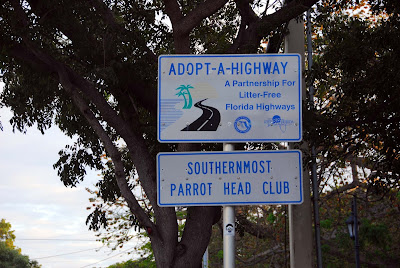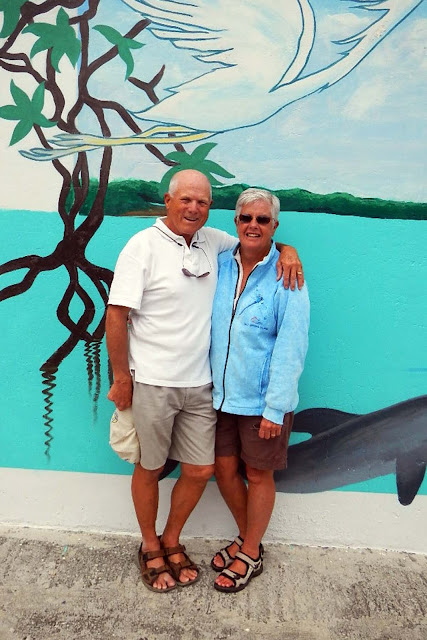. . . IN THE SHADOW OF JIMMY BUFFETT AND ERNEST HEMINGWAY
Since we still had the rental car after the boat show, we decided to make our second quick visit to Key West. If you've never been to Key West, we hope the photos give you an idea how beautiful it is and how lively and quirky. It seemed like a tamer New Orleans -- with a sea breeze.
We didn't think to take a picture of Margaritaville, the restaurant/bar, -- too many margaritas, we guess -- but did get this one about the Parrot Head Club. Jimmy Buffett's career began to surge, and he moved to Key West, just as the Navy downsized its base there. He let the world know about the island lifestyle found here, and tourists came to seek it. We can't give him all the credit for Key West becoming a tourist destination. He certainly helped
at a difficult time for the island.
at a difficult time for the island.
Where else but in Key West would the taxis be pink?
We like the style of this Duvall Street bike rider with pearl-draped handle bars.
Roosters and hens roam the streets of Key West with huge fines for harming them.
In Cuba, cockfighting was common. When Cubans immigrated to Key West, they brought their fighting birds with them. In the 1970s, Key West banned cockfighting, causing hundreds of birds to be released to the wild -- at the same time that the few farmers left in Key West gave up farming and released their domesticated birds. The results are the beautiful birds that roam the streets and alleys today.
St. Paul's Episcopal Church is one of the largest churches in Key West, with gorgeous stained glass windows.
Somewhere behind this banyan tree is a home built in the 1800s, the Crosgrove House.
The Hemingway Home was the highlight of our last trip to Key West. Here, our tour guide, Bob, points out one of Ernest Hemingway's polydactyly cats lying on his bed.
Hemingway raised polydactyly cats, those with one more digit on each paw than an ordinary cat. Today, the foundation that owns his home continues breeding and caring for some 45 cats, most of which are polydactyly. We think the tour guide said that there was a 50 percent chance the offspring will be polydactyly when the two parents are.
The lace curtains in the kitchen even had cats woven into the pattern.
Visitors linger on the shaded, relaxing grounds of the Hemingway House -- although none are in this photo. The house was a wedding gift from a father-in-law and cost $8,000, which was probably exorbitant then.
Near Mallory Square is Key West's Memorial Sculpture Gardens with busts of about 60 people who contributed to the life in the islands. Ernest Hemingway is above.
Sandy Cornish was a former slave who bought his freedom (yet lost his freedom papers) and lived in New Orleans for awhile. While in New Orleans, word reached him that he was going to be pressed into slavery again. He went to the square and stabbed himself, cut tendons in his legs and cut off fingers to avoid slavery. After moving to Key West, he started a thriving fruit and vegetable farm, founded the African Methodist-Episcopalian Church in the Keys, and eventually became a rich man in the islands.
Eduardo Gato came to Key West from Cuba and founded a cigar industry in the late 1800s. He started his business in the islands with the best tobacco and the best cigar artisans to where it returned over $2 million in exports to the island. He created the first street car system and founded the first hospital to make his workers' lives better.
In the outdoor mall at Mallory Square is Spongeman who obviously made a grab
for Jane . . . or vice-versa.
Mallory Square, Key West's traditional place to view the sunset, is filled with street entertainers like this fire twirler as sundown approaches. Then the party begins (at least, we've heard. We drove back home to Squirt).
We weren't able to connect with our Chattanooga friends, Dan and Virginia, who have a winter home in a floating house in Key West, but we saw them briefly in Marathon later. It's always good to see friends from home.
There is so much more to see in Key West. We barely scratched the surface. As we said to each other, if we saw everything on this trip, there wouldn't be a reason to come back. We have hundreds of reasons.
As we drove home to Squirt from our last trip, we were treated to the most brightly colored rainbow we'd ever seen. Surely the pot of gold is at this end.

















































